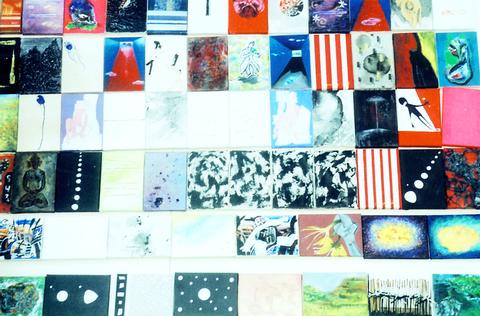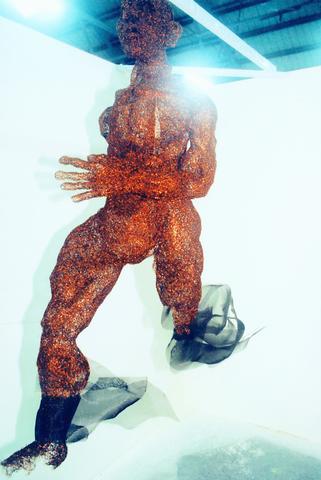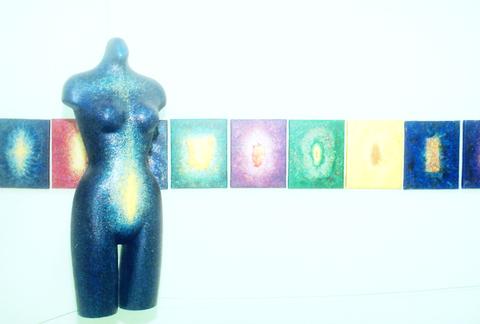As if responding to the commercially successful Taipei Art Fair, which ended two months ago, Mega Arts Lottery -- Artist Exposition
Although sharing the aim of bringing art out of galleries and in front of the public, the more grassroots Exposition, initiated by the artists themselves, is a far cry from the more glamorous Art Fair. For starters, there are no NT$10 million Ju Min

PHOTO: DAVID VAN DER VEEN, TAIPEI TIMES
To place equal value on all the works, the Association of the Visual Arts in Taiwan

PHOTO: DAVID VAN DER VEEN, TAIPEI TIMESN
The small size of the canvas may have limited the artists' creativity in some cases and rendered them similar to merchandise in museum art shops. However, for those intent on treasure-hunting, the lottery does offer some good finds.
This equality between artists is due to the fact that they are all members of the Association of the Visual Arts in Taiwan. "We see the exposition less as a commercial occasion or a promotional campaign for works of art during the economic recession, and more as a rare gathering for our members, who are based in different areas in Taiwan and seldom see each other," said Tseng Chin-kan

PHOTO: DAVID VAN DER VEEN, TAIPEI TIMES
Tseng is also confident that the works on show -- ranging from installation and multi-media, to works on paper and oil paintings -- can attract all kinds of viewers and collectors. "Many young artists joined the association just before the event. Their fresh point of view and preference for creating installation pieces has defined the exposition," Tseng said.
A walk around the exhibit cubicles is full of surprises.
Chiu Yu-wen
Writing poetry and songs in Taiwanese and occasionally making sculptures, Wang Wen-teh (王文德) chose to show the original beauty of his material in The Story of Iron (骨鐵記). For the installation, he places in the cubicle several discarded old-model sewing machines made of cast iron. According to Wang, the material "is the least sculpture-friendly of all and stubbornly resists any kind of shaping. Its lack of ductility seems to suggest a strong character that asserts itself while showing very little of the sculptor," he said. In daily life, cast iron is being gradually replaced by prettier or more convenient industrial materials. However, Wang believes that "if iron had its own recorded history, cast iron would have a lot of story to tell."
These ready-made objects may challenge some viewers' definitions of art and installation. However, it's the way Wang presents cast iron, which highlights the beauty of the metal, that makes the work worthy of its place in the exposition.
Chen Ching-yao
The viewers who had seen the series at the Taipei Fine Arts Museum, where nearly a dozen photos are spread throughout the gallery, will probably find the small cubicle too oppressive for the festive work.
There are also works that made good use of the small space. Among them is Lin Sheng-cheng's
With the highest-priced works -- Yu Peng's two latest works in his ink landscape series -- priced at NT$700,000, the exposition is a good opportunity for salary-earners to start their art collection. It's also a rare artistic free-for-all where viewers can get a glimpse of what they might never see in galleries. Whether "Mega Arts Lottery -- Artist Exposition" will create a sensation akin to the newly launched computerized lottery by presenting works of art in this novel way is something worth finding out in the coming week.

In the March 9 edition of the Taipei Times a piece by Ninon Godefroy ran with the headine “The quiet, gentle rhythm of Taiwan.” It started with the line “Taiwan is a small, humble place. There is no Eiffel Tower, no pyramids — no singular attraction that draws the world’s attention.” I laughed out loud at that. This was out of no disrespect for the author or the piece, which made some interesting analogies and good points about how both Din Tai Fung’s and Taiwan Semiconductor Manufacturing Co’s (TSMC, 台積電) meticulous attention to detail and quality are not quite up to

April 21 to April 27 Hsieh Er’s (謝娥) political fortunes were rising fast after she got out of jail and joined the Chinese Nationalist Party (KMT) in December 1945. Not only did she hold key positions in various committees, she was elected the only woman on the Taipei City Council and headed to Nanjing in 1946 as the sole Taiwanese female representative to the National Constituent Assembly. With the support of first lady Soong May-ling (宋美齡), she started the Taipei Women’s Association and Taiwan Provincial Women’s Association, where she

Chinese Nationalist Party (KMT) Chairman Eric Chu (朱立倫) hatched a bold plan to charge forward and seize the initiative when he held a protest in front of the Taipei City Prosecutors’ Office. Though risky, because illegal, its success would help tackle at least six problems facing both himself and the KMT. What he did not see coming was Taipei Mayor Chiang Wan-an (將萬安) tripping him up out of the gate. In spite of Chu being the most consequential and successful KMT chairman since the early 2010s — arguably saving the party from financial ruin and restoring its electoral viability —

It is one of the more remarkable facts of Taiwan history that it was never occupied or claimed by any of the numerous kingdoms of southern China — Han or otherwise — that lay just across the water from it. None of their brilliant ministers ever discovered that Taiwan was a “core interest” of the state whose annexation was “inevitable.” As Paul Kua notes in an excellent monograph laying out how the Portuguese gave Taiwan the name “Formosa,” the first Europeans to express an interest in occupying Taiwan were the Spanish. Tonio Andrade in his seminal work, How Taiwan Became Chinese,